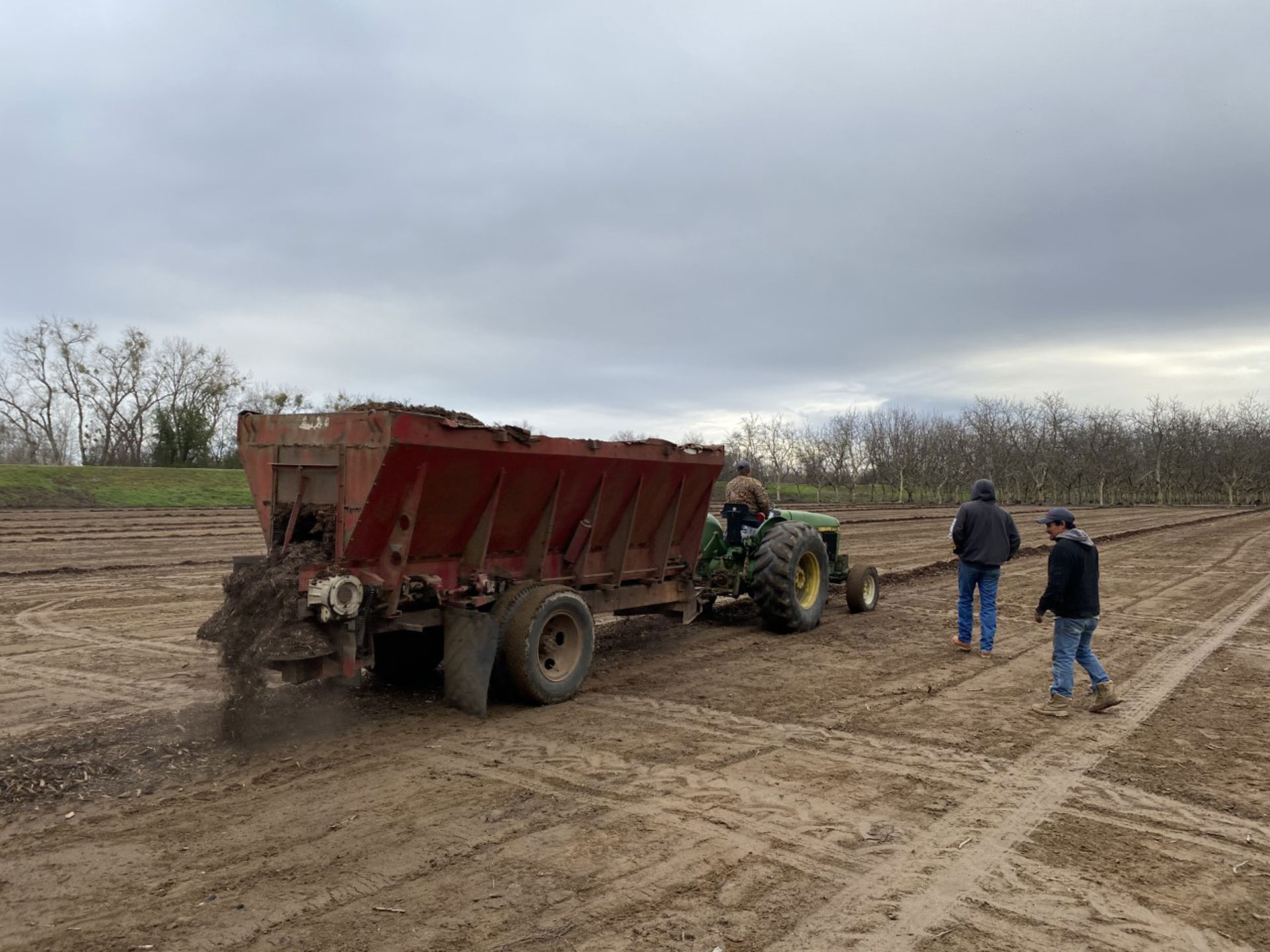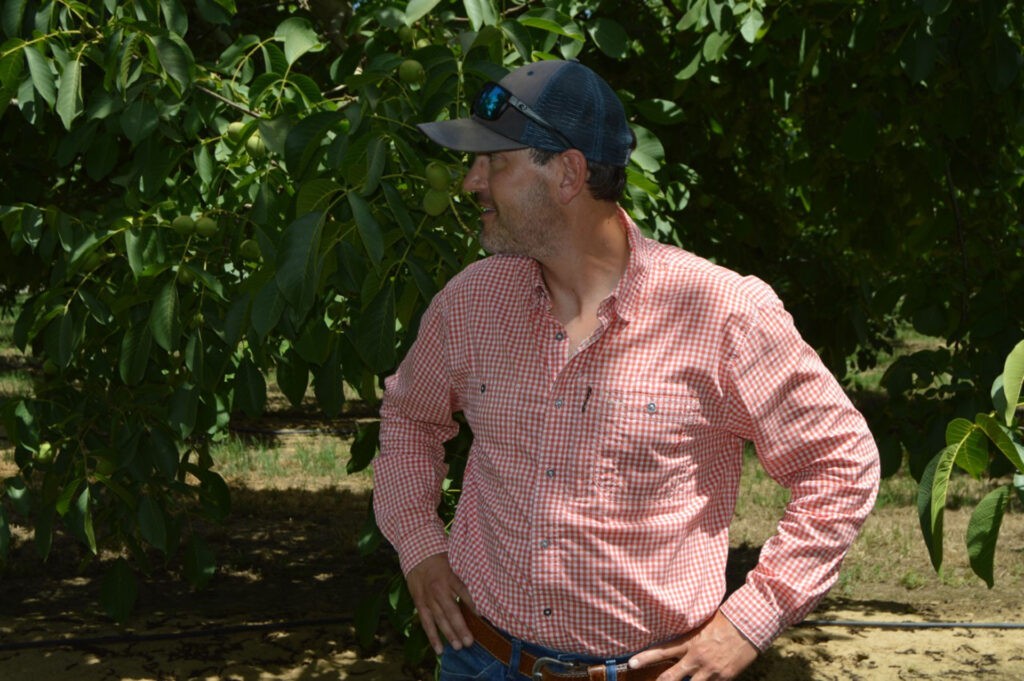
For the past three years, walnut harvest has taken a little longer on one block of Jerry Moore’s Visalia, Calif. farm. There are no weather issues or equipment malfunctions slowing harvest. Moore has volunteered the block to UCCE for research into solving a nematode problem that has plagued walnut growers for decades.
Moore receives no compensation for the extra time it takes as UCCE researchers test and weigh walnuts after each row is harvested. But he rests easy knowing that he is helping growers across the state who have lost yield to nematodes.
“What I get out of it is the gratification of knowing we are helping the industry,” Moore said. “If they can come up with something to solve the nematode problem, it will be a big help to the industry.”
According to researchers, growers like Moore provide an invaluable service for university and USDA researchers as well as for their respective industries.
“We could not be successful farm advisors without grower-cooperators,” said Luke Milliron, UCCE farm advisor for Butte, Glenn and Tehama counties. “There is just no way around it.”
Milliron added that he is fortunate to be centered near a research farm, in his case the Chico State University Farm, where he can conduct certain projects. “But you really need to do this research on different types of ground, with different pests and disease pressure,” he said, “and the only way to find those types of situations is to have these grower-cooperators that are willing to put up with inconvenience and potential loss in some profits by letting you have rootstock blocks and test different materials in their orchards.”
Joe Grant, research director for the California Walnut Board and UCCE farm advisor emeritus, said in many cases, research has to be conducted on-campus or on university field stations. Spraying unregistered pesticides, for example, can’t be conducted on a commercial farm without having to destroy the treated crop. And some research, like evaluating the performance of new varieties and rootstocks, isn’t generally conducive to a grower-cooperator situation.
“No grower is going to want to put up with devoting a lot of space to wait 10 to 12 years for a variety to get evaluated,” he said.
Conversely, Grant said, many research projects can and, in some cases, need to be done in the field.
Pat Brown, UC Davis walnut breeder, noted, for example, that much of his initial breeding work takes place on campus. “But,” he said, “once we are pretty sure that something looks good, we need growers across the state to trial it before we release it. That is a key step in putting out new varieties.”
Grant agreed. “It allows researchers to test things in a much broader variety of settings and management styles than we could ever do on campus. So, that is very valuable. It is a quicker route to ultimate successful adoption when you can get a new technique or new variety or new rootstock looked at across a broad range of conditions.”
Give and Take
Grower-cooperators typically reap some benefit from participating in research, according to growers and researchers. Many like being on the cutting edge of new advances and seeing them at work on their farm, Grant said. But they also encounter inconveniences in working with researchers, and it can be a financial burden.
“The grower usually ends up sacrificing something, whether it be yield, profit, convenience or time,” Grant said. “But I think some growers volunteer to do these kinds of things because they want to see what is coming. They want to kind of be on the leading edge of learning what is happening in a particular domain, like what is the latest findings on walnut blight.
“It is kind of a give and take thing,” he said.
Davin Norene of Rio Oso, Calif. has been cooperating with researchers throughout his career. In his case, he said, it is a family tradition. “My dad has always cooperated with the UC Extension and USDA researchers who are looking to move the industry forward, and that is how I learned. That is the culture here on our farm,” he said.
“You definitely get something out of it,” he added, “It is all about learning and collaborating. You end up being a better farmer, and maybe you get some new tools out of it. But it is usually more of a financial burden than a financial benefit.”
Milliron characterized farmers who donate ground to research as being service oriented. “Because it is an inconvenience, these folks really do have a service-oriented mindset and are seeing the value for the whole industry by advancing this work,” Milliron said.

“And it is just really tremendous that growers let us do that work, especially as it has gotten much harder for a lot of researchers to use the research and extension center, like the Kearney Ag Center in the Fresno area. The fees associated with having a research orchard out there have become expensive.
“On a grower-cooperator farm, however, it is free,” he said. “Growers typically will be fronting a lot of the costs for testing things like whole orchard recycling, or to conduct an almond or walnut or prune rootstock trial in their orchard.
“All of these things are just such a huge benefit, and hopefully these folks are learning in the process, too,” he said.
Like many researchers, Milliron has several trials in place on farms. “We are in dozens of farmers fields, not only in the three counties in the Northern Sacramento Valley that I serve, but I work with other farm advisors and have plots in growers’ fields in Sutter and Yuba counties,” he said. “And it is the same with other advisors around the state.”
He added that he is fortunate to work with several “really great cooperators.”
“It is hard to find a really great cooperator,” Milliron said. “What it really takes is not only that they are willing to let you do research, but they have to be invested in the research as well. If they are, they are going to keep up on the communications and they are going to let you in to do what you need to do. A good cooperator is going to give you a ‘heads-up’ well in advance of harvest, or when something is going to get sprayed out there.”
‘I Know What It Takes’
Moore, the Visalia walnut grower, said he learned the value of grower-cooperators while serving as chairman of the California Walnut Board’s Production Research Committee.
“I know what it takes for these researchers and how hard it is sometimes to find ground to do their projects,” he said. “So, if I have a chance, I open up some ground for them to come and work.”
Moore just completed the third year of his commitment to the nematode project, and last year, he opened up part of his nursery for researchers to conduct rootstock research.
“I’m excited to see what comes out of that,” he said. “These clones they are looking at have resistance to phytophthora, crown gall and nematodes.”
As for the nematode project, there, too, he is optimistic. “They are getting some good results,” Moore said, results that may prove beneficial for him and many other growers in California.










